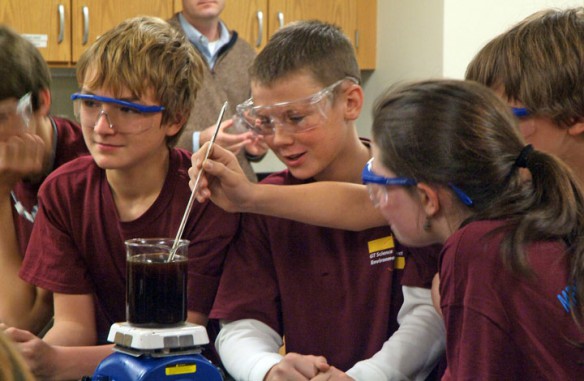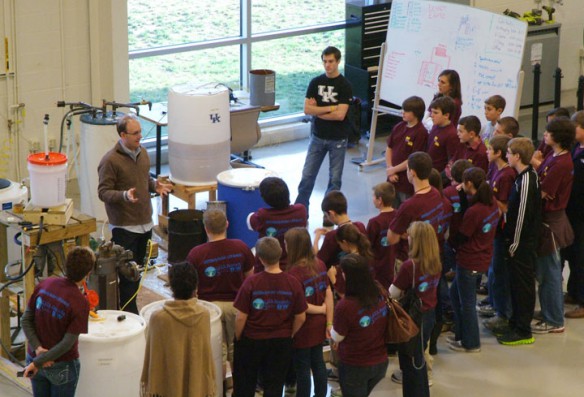
Heath Middle School (McCracken County) students Conner Kelly, Hayden Faughn, Garrett Childress and Katelyn Woodard make biosoap at the Emerging Technology Center at West Kentucky Community & Technical College.
Photo by U.S. Department of Energy
By Matthew Tungate
matthew.tungate@education.ky.gov
When an official with the U.S. Department of Energy offered 6th-grade science teacher Brandy Roberts a chance to take her high-achieving students from Heath Middle School (HMS) (McCracken County) to the Paducah Gaseous Diffusion Plant for some mock water sampling experiments, she jumped at the chance.
“This partnership was an opportunity for HMS to really engage our gifted science students, so as a science department we took the idea and ran with it,” Roberts said.
Heath Middle is now in the third year of a partnership with the Department of Energy and other organizations — DOE environmental contractors, the Kentucky Department of Waste Management and the University of Kentucky College of Engineering at Paducah — that exposes students to hands-on problem solving.
Tammy Weitlauf, an 8th-grade science teacher at Heath Middle who helps coordinate the program, said working with scientists and engineers from the various partners fits schools’ mission.
“As a Kentucky school our focus has shifted so much to college- and career-readiness. These are the children that are going to be filling the jobs of the future that may not have even been created yet. So we’re trying to facilitate to stop looking at us for answers and to be problem solvers, because that’s what it’s going to take for the future,” she said. “We’re trying to nurture these students so they will be able to adapt to new situations and to be those future industry leaders.”
Lisa Santoro, Paducah Department of Energy Site Office project manager, said her agency also benefits from the partnership in several ways.
DOE is always looking for ways to reach out to the community to educate the community on the work that is going on at the site.
“Whenever we can get other entities or other community groups involved it’s beneficial to us in that we’re educating the community on what goes on out here to clean up the environment,” she said.
The large number of scientists and engineers who monitoring groundwater and soil at the plant see a long-term benefit in working with the students, Santoro said.
“If some of the work we do out here helps them decide, ‘Gee, I might look at being an engineer or work with the environment,’ then that’s kind of neat,” she said.
Joe Walker, acting manager of Environmental Communications and Outreach for LATA Kentucky, said the hands-on involvement the students receive could help them determine their college courses and career paths.
“The best way to prepare them for the future workforce is to get them interested and involved now,” he said. “It benefits the businesses in terms of future employment, and it benefits the school system in terms of educating these kids and getting them pointed toward a career that they like and would be fruitful in.”
DOE and LATA Kentucky have been very engaged partners, Roberts said. In the first year of the program, she met with a DOE official several times to review middle school science standards in preparation for the field trip. Then the DOE produced books for students to collect data and produce graphs from their simulated well-water experiments.
“The mentors and business partners have done a fabulous job of planning events and hands-on activities,” she said.
Last year, the partnership got even more involved, Roberts said. About 25 students were divided into grade-level based teams and presented a real problem: elevated zinc levels were found in a water collection ditch called an outfall. Students were challenged to discover where it was coming from and how to reduce the zinc in the water.
Weitlauf, who coordinated most of the activities that year, said more partner groups came on board and offered to serve as mentors to the students. Students visited the plant site several times, worked about an hour after school each week and worked for half a day each month with their mentors.

University of Kentucky College of Engineering professor Jeff Seay talks with students from Lone Oak Middle School (McCracken County) students.
Photo by U.S. Department of Energy
Using data and instruction provided by the mentors, each of the student groups presented possible solutions to not only their mentors but also key administrators from each partner agency, Weitlauf said.
Barton Christmas, now an 8th grader who has participated in all three years of the program, was the lead student on the 7th grade team last year.
He said mentors helped show the students what they would need to know to solve the problem. If students had an idea for a solution, they would ask the mentors, who would share their input from their job perspective and get the students data for calculations.
His group started off with a lot of online research, Christmas said.
“We basically combed the internet for similar situations, things that would help us, just information in general and general statistics for similar situations,” he said.
Christmas said his team found an article online about a Seattle airport with a similar issue. To solve the problem, it implemented a radial flow filtration system, where water goes in to a chamber and, through centrifugal force, zinc is deposited in a filter and the water goes through.
DOE ultimately implemented a similar solution to the problem.
Santoro said scientists and engineers had been working on the problem and had some ideas of how to solve it, but she and the mentors were very impressed with the students’ ideas.
“It absolutely showed these students were thinking, they were analyzing the data, and it was really amazing that they took what some people consider as an extra-curricular, but they really put their heart and soul in it to come up with some really innovative solutions,” she said.
Roberts said she and Weitlauf were both science majors, but students were studying things that aren’t even covered in graduate studies.
“We were learning right along with the kids,” she said.
Watching the students’ problems-solving and teamwork skills grow was amazing, the teachers said.
“Initially students had to overcome the hurdle that they were looking for solutions to problems/questions that did not already have a correct answer,” Roberts said. “Initially, students kept questioning us and the mentors, saying, ‘Are you sure you don’t already know the answer?’ It was an honor to witness the metamorphosis of the students because they are used to adults already knowing the answer. And we didn’t this time.”
But not everything works out as planned. This year, students were going to study alternative uses for the 750-acre site. But due to scheduling conflicts between the schools and community partners, it didn’t work out.
Instead, students from Heath Middle and newcomer Lone Oak Middle have taken a field trip to the West Kentucky Community and Technical College to visit the University of Kentucky College of Engineering, where students learned about the engineering process and collecting and analyzing data. The students also designed and tested a wind turbine and made biosoap from used cooking oil from the cafeteria, Roberts said. Students also will be going to the Paducah Gaseous Diffusion Plant site again for more mock groundwater testing, she said.
“These are all gifted students and we want to continue to open them to not only content and problem solving, but careers and job opportunities in the future,” Roberts said.
MORE INFO …
Brandy Roberts, brandy.roberts@mccracken.kyschools.us, (270) 538-4070




Leave A Comment